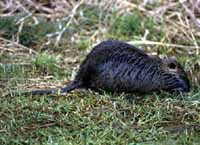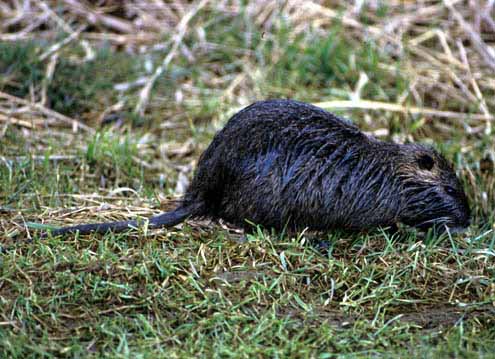Eating out in Louisiana is always an interesting experience for us Texans. One look at the menu and we wonder if we’re still in the good o’l U. S. of A. There’ll be an assortment of dishes and entrees with distinct Cajun sounding names like etouffee, boudin, courtboullion, fricassees of this and that and gumbos made from just about every kind of meat known to mankind. I always seem to get a table front and center, right next to the loud zydeco band that will play nonstop until I leave (I think they play that music to confuse you so you’ll order things off the menu you normally wouldn’t even consider, much less know what they are.)
“How y’all are?” asked the waitress. “Mighty fine, mighty fine - think I’ll just have your Thursday blue plate special - fricassee of ragondin with a side order of rice and beans,” I loudly ordered over the blaring accordion in my right ear. I knew I could depend on the rice and beans being good, but I wasn’t sure about the ragondin, whatever it was. No self respecting Texan would dare ask. The waitress sorta grinned as she scribbled down my order and waltzed back to the kitchen in step with the zydeco beat.
Actually, the ragondin wasn’t too bad – a little chewy with a flavor somewhere between swamp rabbit and dark turkey meat. When I told a friend later about the fine Cajun dish I’d eaten over in Louisiana, he also grinned and informed me that he really didn’t like to eat nutria rat all that much, but to each his own. Nutria!!!!
Nutria (Myocastor coypus) are native to South America. In most of the world (except Louisiana and France where the name translates in French as ragondin), they’re called coypu and their fur nutria. The generic name Myocastor means “mouse-beaver” and the species name coypus was derived from a word in the language of Araucanian Indians of south-central Chile for this aquatic mammal found there. At the tip of South America, they’re found in coastal channels, bays and glacier-fed estuaries.
Nutria is a large rodent in the Family Myocastoridae. At first glance, they resemble beavers but are smaller and equipped with a round, slightly haired rat-like tail rather than a flat one. They’re about 14 inches from nose to the base of their tail that extends another 12-17 inches. Average weight is 12-20 pounds, but some individuals may weigh 25 or more; males are larger than females. Coloration is brownish and there are three layers of fur: three inch primary guard hairs, secondary guard hairs beneath and short underfur which is less dense than that of muskrat or beaver. The ears are small and eyes set high on the head. With relatively poor eyesight, they have developed acute hearing to help elude predators during their nocturnal feeding forays. They can dive and stay under water for up to 10 minutes. Their mouth and nose are valvular (closes under water), so they can bite off underwater plants with their four large incisors without getting water in their mouth. Glands located near the corners of their mouth secrete an oily substance used to groom and waterproof their fur.
Their forelegs are short compared to the hind legs, so when they walk on land they have a hunched profile. Forelegs have five toes, four of which are clawed and used for digging and grooming. Hind toes are webbed, except for the “little toe”, making them strong swimmers. Mammary glands are located high on the female’s side which allows her young to suckle while she swims.
Nutria breed every month of the year and have two or three litters of five or so young. Gestation is 127-132 days and young begin eating green vegetation within a few hours, being born fully furred and with open eyes. Young are capable of breeding at four to five months of age. It doesn’t take long for a population of nutria to become established, and before you know it, there’s more nutria than you can shake a stick at.
They’re vegetarians and will eat two to three pounds per day of aquatic and semi-aquatic plants like cattails, reeds and sedges. Some will venture onto land or into farmland fields to chow-down on crops or other succulent vegetation. In swamps and bayous, they assemble floating platforms of vegetation where the live or they’ll invade muskrat or beaver houses. They’re not without their enemies including alligators, turtles, snakes and us.
Nutria were first introduced in Elizabeth Lake, California, in 1899 for fur farming and later in Washington, Oregon, Michigan, New Mexico, Utah, Ohio, Louisiana, Texas and other states. Feral populations soon became established from nutria that escaped or were released from unsuccessful farms. Hurricanes were thought to have contributed to their spread along the Gulf Coast and by the 1950s, high populations were reported from southeast Texas to the Mississippi River. The fur trade has had its ups and downs and now its down. At the peak, millions of nutria were harvested annually for their pelts and shipped to European markets for making fur coats and garment trim. In Louisiana, efforts have been made to promote the culinary delights of their meat (they market it as Neaux-tria) which is high in protein, low in fat and cholesterol and not too bad if you don’t know what you’re eating.
They were also promoted for control of nuisance aquatic vegetation such as water hyacinth but eventually became pests themselves by depredating sugarcane and rice crops and devouring aquatic habits used by other wildlife species such as muskrats and waterfowl. Their inclination to burrow into levees, dikes and other earthen embankments makes them a target for control measures and not welcome down on the farm. Nutria itch, caused by a parasite found in the larvae of the Strongyloides nematode, can be transmitted to humans exposed to water contaminated with nutria feces, resulting in seven to 10 days of extreme itching of the skin and a rash.
Although not native to Texas, nutria are found in aquatic habitats throughout the eastern two-thirds of the state and also here in the Cross Timbers. They’re adaptability and spread is another example of “it’s not nice to mess with Mother Nature.” Next time you’re in New Orleans, try Chef Philippe Parola’s Ragondin au Choux Rouge (nutria with caramelized red cabbage and honey mustard sauce) – they say it’s finger lick’en good – I gaaaar-un-teee! Until next time, I’ll see you down the road and God Bless America.



